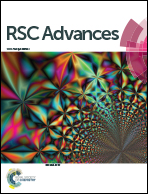Synthesis, characterization and optical properties of novel dendronized azo-dyes containing a fullerene C60 unit and well-defined oligo(ethylene glycol) segments†
Abstract
Herein, we report the preparation and characterization of a novel series of dendronized azo-dyes containing a fullerene C60 unit and well-defined oligo(ethylene glycol) spacers. The azobenzene units present in these dyes were substituted in the 4′-position with different functional groups (–H, –OCH3, –C4H9, –CN and –NO2). The optical properties of these compounds were studied by absorption spectroscopy as a function of the dipole moment of the azobenzene moieties. All fullerene C60-azobenzene derivatives exhibited trans–cis photoisomerization and photoprotonation under irradiation with UV-light. The results were compared to those obtained with their precursor azo-dyes without fullerene C60. It was found that the presence of the fullerene unit significantly quenches the photoisomerization yield, whereas the photoprotonation was not affected by the presence of this chromophore.



 Please wait while we load your content...
Please wait while we load your content...